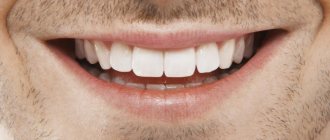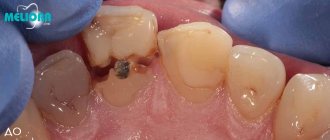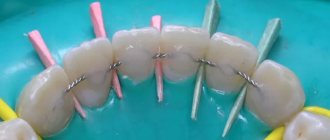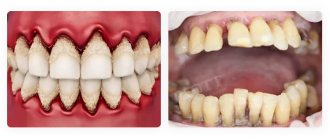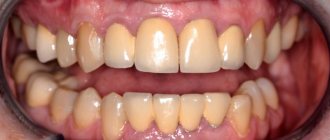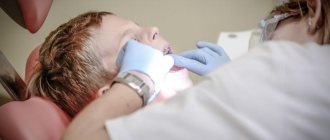Problem: a man came to the Family Dentistry whose front teeth began to become loose. I haven’t been to the dentist for a long time, problems have been piling up. According to the diagnostic result:
- 8 teeth missing
- chronic generalized periodontitis,
- several teeth are badly damaged,
- several teeth are loose,
- there is inflammation at the roots of two teeth,
- right-sided sinusitis,
- a lot of dental plaque,
- acute inflammation of the gums near the front upper tooth and general inflammation of the gums.
Complex treatment is required, saving the remaining teeth and restoring missing teeth.
Solution: a comprehensive treatment plan has been drawn up, but since the patient cannot currently begin the full scope of treatment due to financial difficulties, the most important steps have been completed that will prevent further tooth loss - removal of dental plaque, removal of 6 teeth, temporary prosthetics of the front tooth (adhesive bridge prosthesis on legs made of aesthetic plastic), treatment of tooth canals with a microscope, treatment of sinusitis.
Diagnosis and treatment planning for periodontitis
The patient complained that his front teeth began to become loose and his upper tooth began to hurt. During the examination, the dentist found out that 8 teeth were missing, and there were many problems with the rest.
Problems during inspection:
- On the lower jaw, only the root remained of one tooth.
- On the upper jaw, the chewing tooth is severely destroyed.
- Some teeth have protruded towards the opposite jaw.
- The central lower tooth is very loose.
- There are a lot of deposits on the teeth (plaque, tartar).
- The gums near the upper tooth are very inflamed, the tooth hurts when pressed.
- Old fillings on teeth - unaesthetic fillings on the upper front teeth, a sagging filling on a chewing tooth.
To understand the condition of the bone, a computed tomography scan of the teeth was performed.
The main problems with the image:
- Critical loss of bone tissue in the area of the lateral teeth and the lower front tooth.
- Inflammation at the roots of the two front upper teeth on the right.
- Inflammation in the maxillary sinus (sinusitis).
A computed tomogram of the teeth shows that the central lower tooth (the tooth was loose) practically does not hold in the bone, the bone tissue around the root is sparse.
Diagnosis
– partial secondary adentia (loss of teeth), chronic generalized periodontitis, malocclusion, right-sided odontogenic sinusitis.
The reason for this condition was the lack of prevention (the patient had not visited a hygienist for several years) and regular dental examinations. Tooth loss can be prevented by taking good care of your health. Visit your dentist, even if you have no complaints, twice a year!
Comprehensive treatment plan:
- professional oral hygiene to remove all deposits and prepare for dental treatment,
- revision and removal of failing teeth,
- treatment of tooth canals (the roots of which have inflammation and treatment is advisable),
- treatment of sinusitis,
- installation of dental implants in the lower jaw with plastic surgery of bone and soft tissues,
- prosthetics of lower teeth on implants,
- prosthetics of the upper teeth with removable telescopic dentures,
- restoration of the remaining teeth with ceramic crowns.
The estimate for complete treatment was 1,804,974 rubles.
At the moment, this amount is unaffordable for the patient, since his wife is undergoing bite correction and dental prosthetics at Dial-Dent (in fact, looking at his wife, the man decided to visit the dentist). Due to the difficult financial situation, it was decided at this time to do everything necessary to eliminate the development of periodontitis and prevent the loss of remaining teeth.
Abbreviated treatment plan (elimination of emergency problems):
- Professional oral hygiene.
- Removal of 6 failing teeth under sedation.
- Treatment of sinusitis.
- Treatment of canals of two front teeth under a microscope.
- Temporary aesthetic prosthetics for the removed lower anterior tooth.
Such an abbreviated plan (with an estimate of 83,000 rubles) provides for the continuation of treatment at any time, the logic of the stages will not be disrupted, and the health of the dental system will be preserved as much as possible before moving on to further treatment. The main thing is not to delay the restoration of teeth too much, since without load (without installing implants) the jaw bone is prone to thinning, and chewing without teeth in the lateral sections is very uncomfortable, the joints are overloaded.
Superstitions related to teeth
After it became clear what to do with a lost tooth, it was time for superstitions. Here are just a few beliefs that help determine a person’s future:
- A gap between the incisors indicates a joker and a merry fellow. Such a person will always be the life of the party. And, if a child has such a gap, then he is destined to become a businessman or a major financier.
- To prevent jaw pain, you should not spit out the window.
- The child, born with teeth, was predicted to have a future as a powerful magician.
- When the first tooth begins to cut, relatives give the baby’s parents a silver spoon. The child should gnaw it, then he will not have to “gnaw” his way in life, everything will be easy for him.
- If a baby tooth falls out, the sign says that by secretly sewing it into your husband’s clothes, you can turn your husband away from gatherings with friends and other girls. He will want to be home as soon as possible. Some mothers take advantage of this moment.
- It is better to melt crowns into jewelry, because they store all the information about a person, his energy.
- A wisdom tooth signifies a new stage in a person’s life. The more painfully it is cut, the steeper the changes will be. The longer he can’t get out completely, the more professional a person becomes in his business. Having crumbled during pregnancy, it predicts a capricious baby with whom parents will fuss both in childhood and in adulthood.
If no interpretation inspires confidence, you can simply bury the fang or incisor in the ground. Even a flower pot will do.
Advantages of treatment at Dial-Dent
There is a great advantage in clear treatment planning and budgeting. The patient knows the cost of treatment in advance (and does not find out about the upcoming expenses in the middle of the journey, when it is no longer possible to suspend treatment), plans his time and finances. With clear planning, costs are reduced (for example, when installing an implant, bone or soft tissue plastic surgery can be performed immediately, rather than breaking this process into two operations, using sedation twice), time is saved (several specialists can be visited in one visit to the clinic).
Proper treatment planning is helped by the fact that the clinic is equipped with modern diagnostic equipment (including a computed tomograph) and employs all the necessary specialists.
Option 4 – give it to the tooth fairy
This tradition has purely American roots, when children put their lost tooth on a beautiful plate, and in the morning a toy, souvenir or some kind of tasty treat appears in it. This technique works especially well for those who had to have a baby tooth removed at the dentist’s office. A little pleasantness allows you to quickly switch from unpleasant sensations to positive thoughts and, accordingly, forget them as soon as possible. Again, a strong connection is formed in the brain between “a tooth fell out and a present.”
It sounds strange, but in practice, children whose parents offer such a mini-performance are less afraid of going to the doctor in the future.
Professional dental hygiene
Professional hygiene is necessary before tooth extraction or implantation to reduce the microbial load. In this situation, removal of all dental plaque is also necessary for the treatment of periodontitis and elimination of gum inflammation.
After professional removal of plaque and tartar, the hygienist selected products for independent oral hygiene that will most effectively remove dental plaque and prevent gum inflammation, and taught a technique for brushing teeth that does not injure the gums.
Tooth extraction under sedation
Some teeth could not be treated. Removal of failing teeth was even necessary to stop the inflammatory process and bone loss.
Tooth extraction under sedation relieves stress and increased blood pressure. The patient is in a state of medical sleep while the teeth are removed and sutures are applied, and after the operation he quickly comes to his senses, without unpleasant memories. The operation lasted 1 hour.
Two weeks after the teeth were removed, the condition of the gums improved noticeably.
Causes of tooth loss in adults
The acids contained in plaque over time destroy the hard tissues of the teeth and provoke inflammatory processes in the gums. This is how diseases begin that cause teeth to fall out in adults.
- Periodontitis Long-existing plaque attaches to the teeth and begins to mineralize. Gradually it goes down below the gum, causes inflammation and begins to destroy the ligament that holds the tooth in the bone. As a result, the periodontal ligament and bone tissue are destroyed, and the tooth becomes mobile.
- Periodontitis If caries is not treated, the infection gradually penetrates first into the dentin, then into the pulp of the tooth, and then reaches the periodontal tissues. This inflammation leads to destruction and subsequent loss of teeth.
Temporary prosthetics of the front tooth
Since at the moment the patient cannot begin implantation and dental prosthetics with ceramic crowns, and the absence of a front tooth greatly affects the aesthetics, it was decided to perform a temporary prosthesis for the front tooth. An adhesive cuspid bridge was chosen as a temporary prosthesis.
To make a temporary dental prosthesis, impressions of the teeth must be taken. Taking impressions of teeth in the traditional way, using impression material, is not suitable for all patients: some patients experience a gag reflex when taking impressions, and it becomes impossible to remove the impression, and some patients with loose teeth experience nervousness, fearing that they will lose a tooth when taking an impression.
Family Dentistry offers an alternative to traditional impressions - dental scanning. Using dental scanning, the doctor receives three-dimensional digital models of the jaws, from which he can model crowns, inlays and dentures. The doctor transfers the digital models and simulation results to the dental technician, who makes the dental restorations.
The front tooth prosthesis is made of aesthetic plastic. Such a tooth will be attached to the neighboring ones with special linings on the inside, that is, the neighboring teeth are not ground down.
This option is temporary, but it restored the aesthetics well. Later, when the patient is ready, the front tooth will be restored with a ceramic crown on an implant, and the neighboring ones will be restored with ceramic crowns - then the aesthetics will be ideal.
A baby tooth has fallen out - what to do?
American beliefs have reached Russia.
It's about a little fairy who flies in at night and takes baby teeth. In return, she gives the baby a coin or sweets. To do this, you need to put the tooth under the pillow and try to fall asleep faster. Another, less common belief came to Russia from England. According to the tradition of the British, if you have a tooth that has fallen out, you need to say goodbye, namely, salt it and burn it. This tradition is justified, since no one will be able to use it for witchcraft purposes. The British also believe that if an animal finds it and swallows it, the person will have an ugly smile or grow crooked fangs.
Among the Slavs, the tooth had to be thrown behind the stove. Along with this gesture, an ode of praise was sung to the spirit of the house, in the hope that he would take care of the health of the residents. Instead of a fairy, a mouse took a tooth from under the pillow of Slavic children. In order for everything to go smoothly, before going to bed you had to say:
The gypsies buried them, saying words for good luck that would protect the child throughout his life. Asians, reading conspiracies for protection from troubles and diseases, threw a fallen fang or incisor onto the roof of their house and went to bed.
Treatment of tooth canals under a microscope
To eliminate inflammation at the roots of the two front teeth, dental canal treatment was performed under a microscope. The significant magnification provided by the microscope helps to thoroughly clean the canals of the teeth and not miss the branches and bends of the canals. Thanks to the professionalism of the endodontist and excellent equipment, the infection in the canals, which causes inflammation at the roots, is completely eliminated.
After dental treatment under a microscope, the canals are hermetically sealed and the bone at the roots is restored. Treatment under a microscope saves teeth from removal.
Sign of the appearance of the first tooth
For an accurate interpretation, it is recommended to pay attention to the age of the baby, whether a bone unit appeared above or below, in what condition, and how the baby suffered this event.
Signs and customs about the first tooth are based on the observations of ancestors and recommend what to do correctly to avoid unpleasant situations and protect the child from evil. In the modern world, most of them seem stupid and savage, but some are observed with precision under the supervision of vigilant grandmothers.
Traditions, beliefs and signs when a baby’s first tooth comes out:
- Whoever first noticed the appearance of a chisel should be given an expensive and useful gift.
- The godmother or godfather gives a silver spoon, which needs to be tapped on the tooth. It is believed that this will help all subsequent units grow smooth, strong and healthy.
- The first tooth appears on top - mom will soon become pregnant. This is also indicated by early teething.
- Doesn't appear for a long time - the child will grow up to be a talented, lucky, happy person.
- A fang erupted earlier than others - to a bad life, a difficult fate.
In rare cases, the first tooth is noticed in a newborn immediately after birth. Folk signs and beliefs predict an unusual fate for such a baby.
It was believed that man came to our world with some important mission. He has all the necessary inclinations and talents for this, which should be properly developed by his parents.
Prevention of periodontitis
To prevent periodontitis, the patient is recommended to undergo professional teeth cleaning twice a year. If plaque forms on your teeth quickly, or you have problems with self-hygiene, then it is better to visit a hygienist more often, this will preserve the health of both your teeth and gums. Read more about prevention and hygiene measures here.
The patient took a break for some time to prepare financially for further treatment. Doctors did everything to maintain the health of the dental system while waiting.
Is it possible to keep fallen and pulled out teeth at home?
The loss of a child’s first baby tooth is one of the most striking events in every family, because, as a rule, it happens on the threshold of independent life, when school is already looming on the horizon. In memory of this important stage of growing up, parents often strive to preserve the first incisors that fell out, next to the tag from the maternity hospital, the first lock of hair cut, and casts of the baby’s tiny hands and feet. However, according to popular belief, storing teeth at home is strictly not recommended. Let's try to figure out why you can't keep them at home, and whether this is actually true.
Dial-Dent specialists who took part in this treatment
- Orthopedic dentist S.V. Zukor – diagnostics, treatment planning, preparation of treatment estimates.
- Surgeon T.R. Zhazykoev – tooth extraction under sedation.
- Anesthesiologist V.S. Kulakov – conducting sedation, monitoring the patient’s condition.
- Dentist-endodontist Yu.A. Borisova – treatment of dental canals under a microscope.
- Dental hygienist E. Smirnova – professional oral hygiene, preparation for dental treatment, selection of hygiene products, training in brushing teeth.
- Dental technician D.V. Wolf – making a temporary denture.
- Dental assistants L. Kharlamova, A. Antoshkina.
See other examples of dental treatment and prosthetics here.
Make an appointment for a consultation by phone +7-499-110-18-04 or through the form on the website. You can ask questions about dental treatment and prosthetics to the chief doctor of the clinic, Sergei Vladimirovich Tsukor, at
Children and adults
Lost teeth in a child aged 6–8 years is a natural process of changing milk teeth to permanent ones. Most often, the baby loses them in the same order in which they erupted. There is no exact age when this happens, since this condition is individual for each baby, but it happens absolutely painlessly and is safe for the body.
However, if a tooth falls out in adulthood, this is a sign of a serious pathology, which is most often associated with poor hygiene, bad habits and resulting diseases. Delayed treatment and negligent attitude towards teeth care can lead to their loss.
In turn, an incomplete row leads to displacement of the teeth: they move closer together, as if filling the resulting gap. This state of affairs can lead to the following consequences:
- the bite is disturbed;
- cracks form;
- teeth become loose;
- periodontitis develops.
Absence of teeth leads to displacement of the remaining ones and the formation of gaps
There is a misconception that older people always start to lose teeth, but this is not true. The process has nothing to do with age. Teeth can be kept healthy and strong if you take proper care of them, take vitamins, give up bad habits and visit the dentist regularly.
Many mothers wonder which teeth fall out first. Depending on the child’s body, milk falls out at 6 or 7 years of age. The baby loses them in the same order in which they erupted; for example, you can see that the front tooth has fallen out if it erupted first. If the lower incisors erupted first, they will be the first to leave their place.


